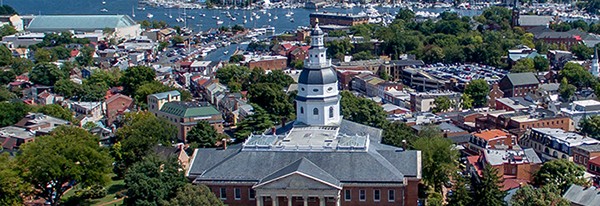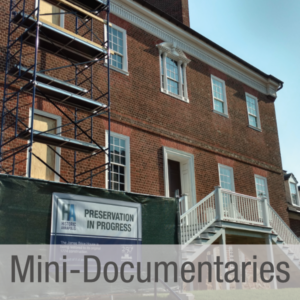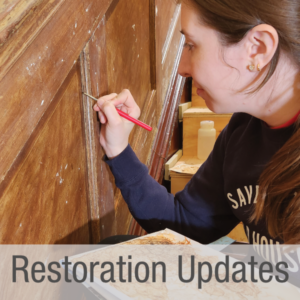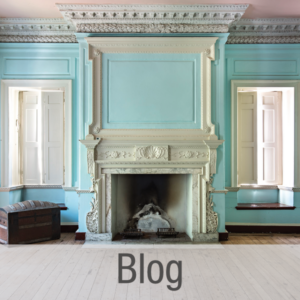Due to the restoration project, the James Brice House is currently closed to the public.
The James Brice House is one of the largest and most elegant of Annapolis’s historic homes, and one of the most important surviving structures from colonial America. Recognizing the importance of the architectural gem, the State of Maryland purchased the James Brice House in 2014 and arranged for Historic Annapolis, Inc. (HA) to maintain and manage the National Historic Landmark property. In 2016, HA embarked on a multi-year, multi-million dollar restoration of the James Brice House. The experts HA has assembled for this project are highly respected in their fields, are known world-wide and have worked on the nation’s most important historic structures including Mount Vernon, Monticello, Montpelier, Drayton Hall, and the Maryland State House.
James Brice House
42 East Street
Annapolis, MD 21401
410.267.7619
James Brice was a lawyer and planter, enslaver, a local and county officeholder, a member of Maryland’s Executive Council for many years, and acting Governor in 1792. He and his wife, Juliana Jennings, had seven children. Thanks to Brice’s detailed account book, we know much about the construction of his five-part Georgian house, one of the largest and most elegant of Annapolis’s historic mansions. Work began on April 14, 1767 with the laying of a cornerstone marked “The Beginning.” Seven years, 326,000 bricks, and 90,800 cypress shingles later, the house was completed at a cost of just over £4,014 in colonial Maryland’s currency.
The Brice House contains extraordinary evidence of the lives and the handiwork of everyday people who created the building’s masterful architectural structure and finishes and then continued to toil for the Brices. It is estimated that up to 28 individuals were enslaved at the home or forced to labor in its construction by Brice, based on the account book. The 1802 inventory of James Brice’s property included 11 enslaved people who ranged in age from 3 to 58: Tom, Doll and her son Jesse, Nan and her sons Isaac and Nathan, Jenny and her daughter Kitty, Henny and her daughter Caroline, and a child also named Henny.
The house stayed in the Brice family until the 1870s, when it was purchased by the Martin family, and in 1911 it was bought by the proprietors of the nearby Carvel Hall Hotel. St. John’s College acquired the house in 1927 and converted it to faculty apartments. Stanley and Helen Wohl bought it in 1953 and restored it to single-family use. In 1979, the International Union of Bricklayers and Allied Craftsmen purchased the house (later known as the International Masonry Institute) and began using it for office and meeting facilities. Recognized as one of Maryland’s most important historic resources, the State of Maryland purchased the James Brice House in 2014 and arranged for Historic Annapolis, Inc. (HA) to maintain and manage the National Historic Landmark property.
Historians today commend James Brice for the extraordinary accounts of the work he kept during the construction of the Brice House, built with the skill and discerning eye of a laboring class and with the aid of a talented but enslaved work force. The extent of the documentation for the Brice House is paralleled by few other colonial American endeavors, perhaps matched only by the overly obsessive record keeping of Thomas Jefferson at Monticello and by the meticulous writings of George Washington about his Mount Vernon estate. Although James Brice clearly had a hand in the design and construction oversight of his town dwelling, he appears more trusting of the tradesmen he selected to engage in his project than did his Virginia counterparts.
The building left by Brice and the handiwork of the workmen who erected it are extraordinarily intact. The house holds the potential to go beyond the traditional historic house museum to tell a greater story, which will emphasize both the contribution of those who toiled to make the structure what is was in 1774, and highlight the skills of a new generation of builders, conservators and technicians who will restore the house to its former glory.
HA intends to restore the James Brice House to its completed 1774 appearance. The result will be an academically sound, museum-grade restoration of the exterior and interior of the house implemented to the highest standards applied to traditional building restorations. Since the house retains most of its original fabric in the center block, much of the work beyond replacement of building systems will focus on a state-of-the-art restoration of finishes (plaster, paint, masonry, wood elements, etc.) and replacement of its few missing parts.
Once the restoration is complete, the house will be open to the public for tours, preservation research, meeting space, educational programming, and exhibitions showcasing the building’s extraordinary architecture and history.
A Cup of Rum and Other Reasons One of Annapolis’ Greatest Historic Houses Is Worth Celebrating – National Trust for Historic Preservation, April 16, 2018
Brice House Goes Window Shopping – Bay Weekly, September 1, 2022
‘We have our work cut out for us’: National Park Service funds window restoration at historic Brice House in Annapolis – Capital Gazette, September 2, 2022





